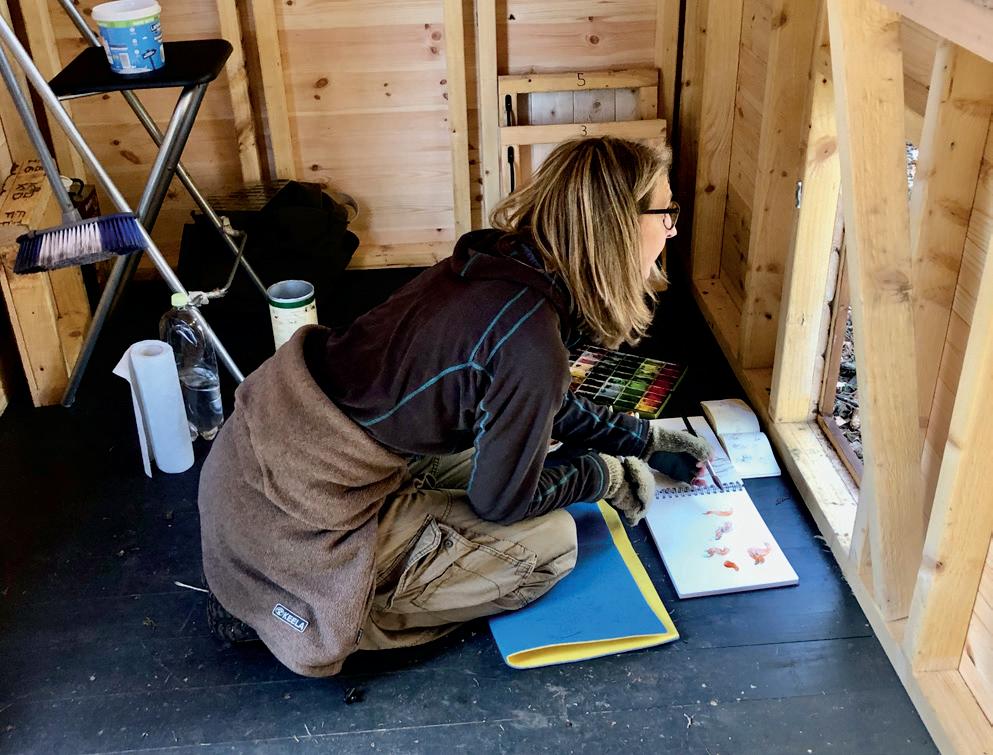CLAIRE HARKESS RSW
Fine Feather







Artist Claire Harkess RSW deserves to be considered a modern master in her field. Having left Glasgow School of Art in 1993, she has spent the last 30 years studying and observing the natural world, skilfully capturing wildlife and their habitats through the medium of watercolour.
Elected as a member of the Royal Scottish Society of Painters in Watercolour (RSW) in 2005, Claire’s international acclaim grew further in 2017 by winning the David Shepherd Wildlife Artist of the Year award in London – a revered wildlife art competition and exhibition open to artists worldwide.
It’s Claire’s relentless drive to push boundaries and experiment with her art that sets her above other artists and is pivotal to her success. Behind each of her beautifully delicate and effortless looking paintings is a huge degree of thought and complexity. Each piece is a careful balance – what paper type to use, what brushes to use (of which her collection is immense) and how to apply and mix the paint and water together are all critical considerations. Claire has been continually honing her talent since leaving art school, trialling different materials and brushes, manipulating the paint and studying painting techniques across the world to continue to challenge herself to experiment and push herself every time she picks up a paintbrush.
In this latest collection of work, Claire combines heavy papers and boards with infinitely fragile transparent Chinese papers and papers that have been used as ledgers in Japan. Rich swathes of vibrant colours are created by building up and washing down layers and layers of paint – the backgrounds a stark contrast to the elegant but powerful compositions of the subject matter using minimalist brushstrokes, some intertwined with Japanese calligraphy.
To seek inspiration for her work, Claire has travelled off the beaten track to some of the furthest reaching corners of the earth, like Svalbard, Kenya and the Galápagos islands. However, with recent world events, she has focussed her painting closer to home and the natural world in her immediate vicinity. Wherever her subjects, she fully immerses herself in the outside environment: whether camping outside in a woodland hide, facing the elements head on in national park, or studying life in an urban hedge. Claire intently observes and scrutinises the wildlife and their habitats, hours and days at a time, creating endless sketches, striving to capture a moment. Some of the works are created on location ‘en plein air’ allowing the brush to move organically, the paint flowing freely and the paper integrated into the ground, rather than on an easel.
This inspiration for this Solo Exhibition is centred around Claire’s home region of Perthshire and focuses on a species that we are all familiar with and fortunate to encounter in our daily life – Birds.
Susan Bennett, April 2023 Strathearn Gallery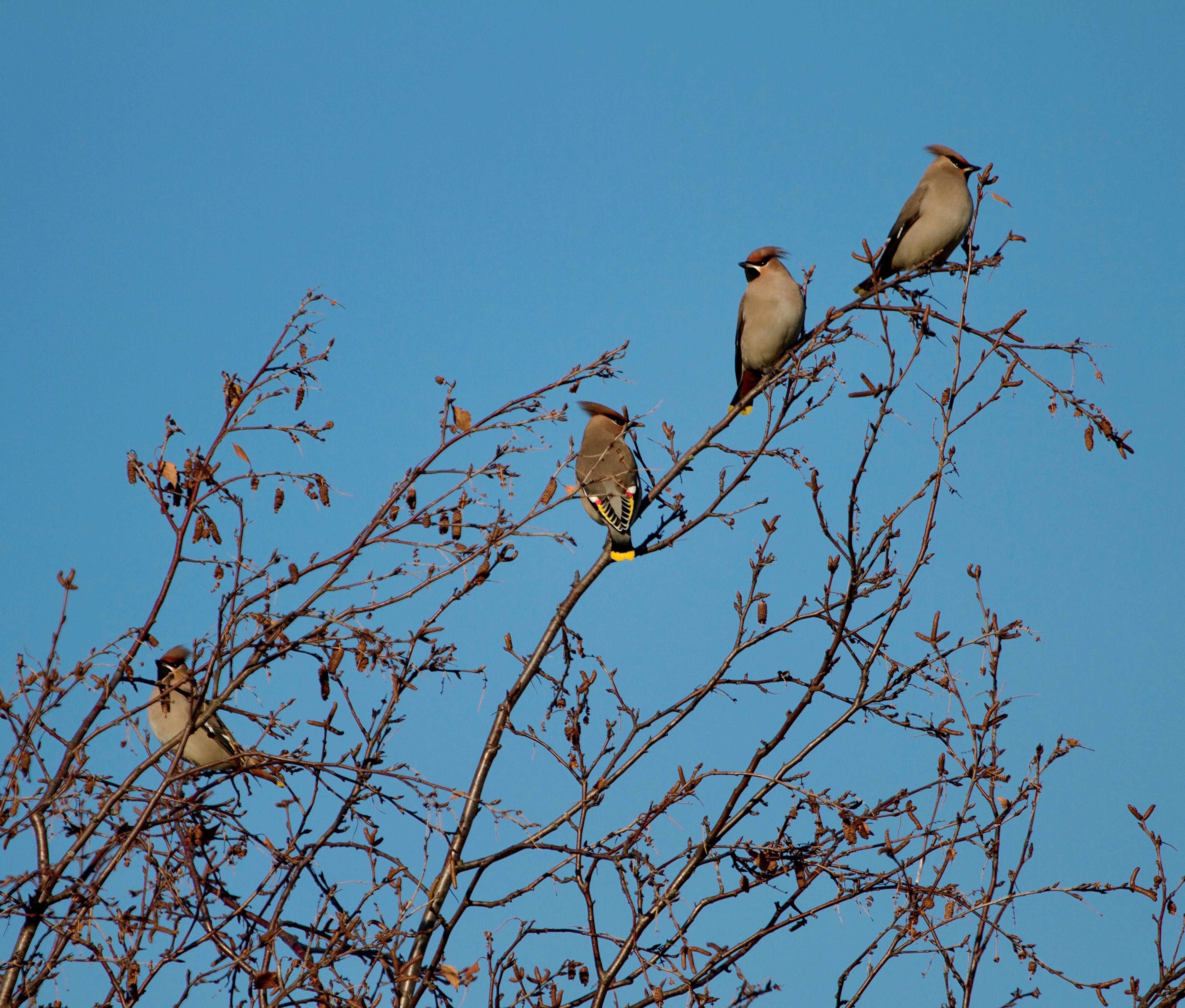
“Stepping outside, it’s almost impossible to not see or hear a bird. This familiar natural world is full of moments of ordinary wonder and nature is everywhere. To be present is key - even a supermarket carpark can produce an unexpected encounter - a glimpse of a nuthatch scurrying up a tree, a call piercing the night. It is the joy and challenge of each moment that keeps me returning to this bird world and there is so much going on.
This exhibition is a collection of these moments - focusing on native birds and flora. Painted over the seasons, different aspects come to the fore from a bursting rose in July to the skeletal framework of a rowan tree where blackbirds wait for breakfast to be served.
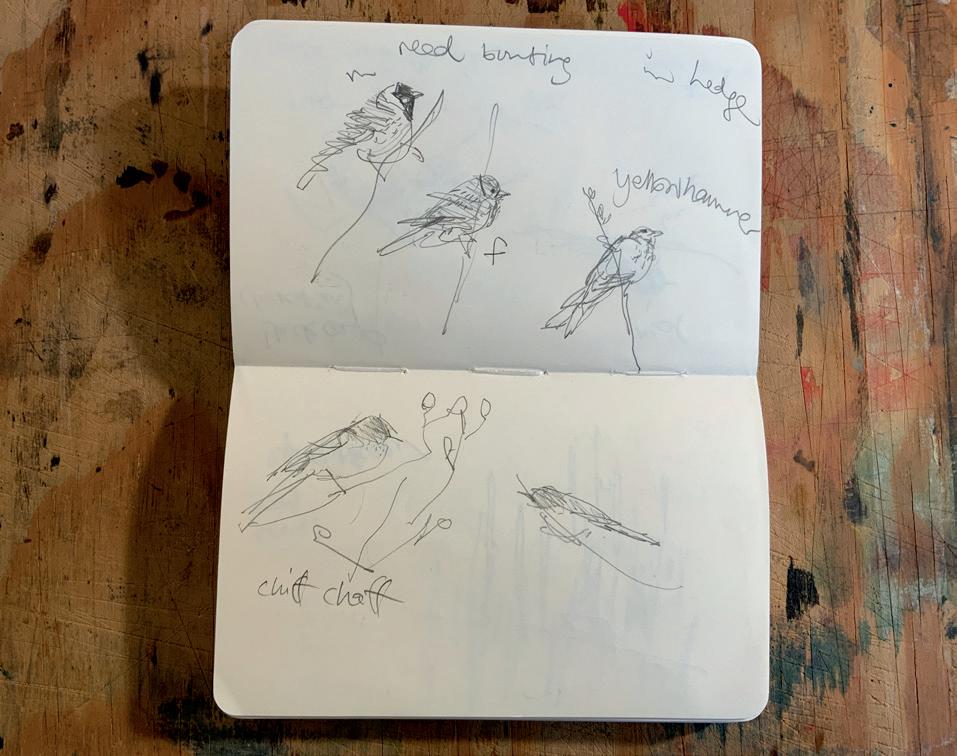
I work with watercolour in different ways. On very heavyweight paper, layers can be put down, washed out, repainted, building up rich and colourful marks.
In contrast I enjoy the discipline of a more calligraphic approach. The pared down simplicity of a brushmark is like that of a haiku. The challenge - to say as much with as little as possible, without embellishment, is a delicate balance. There is no room for indecision or timidity. It is of a moment, direct and immediate and gets to the heart of the matter.
So easily taken for granted, it is unthinkable birdsong should ever fall silent. Yet for a long time birds and the natural world have faced a myriad of threats- over exploitation, climate change, habitat loss, and most recently the devastating effect of avian flu.


Their call is our call and this exhibition is a small shout out on their behalf”.
Claire Harkess RSW March 2023Garden Flock: Bullfinch & Rosehips i, watercolour, 10 x 7cm

Garden Flock: Chaffinch, watercolour, 10 x 7cm
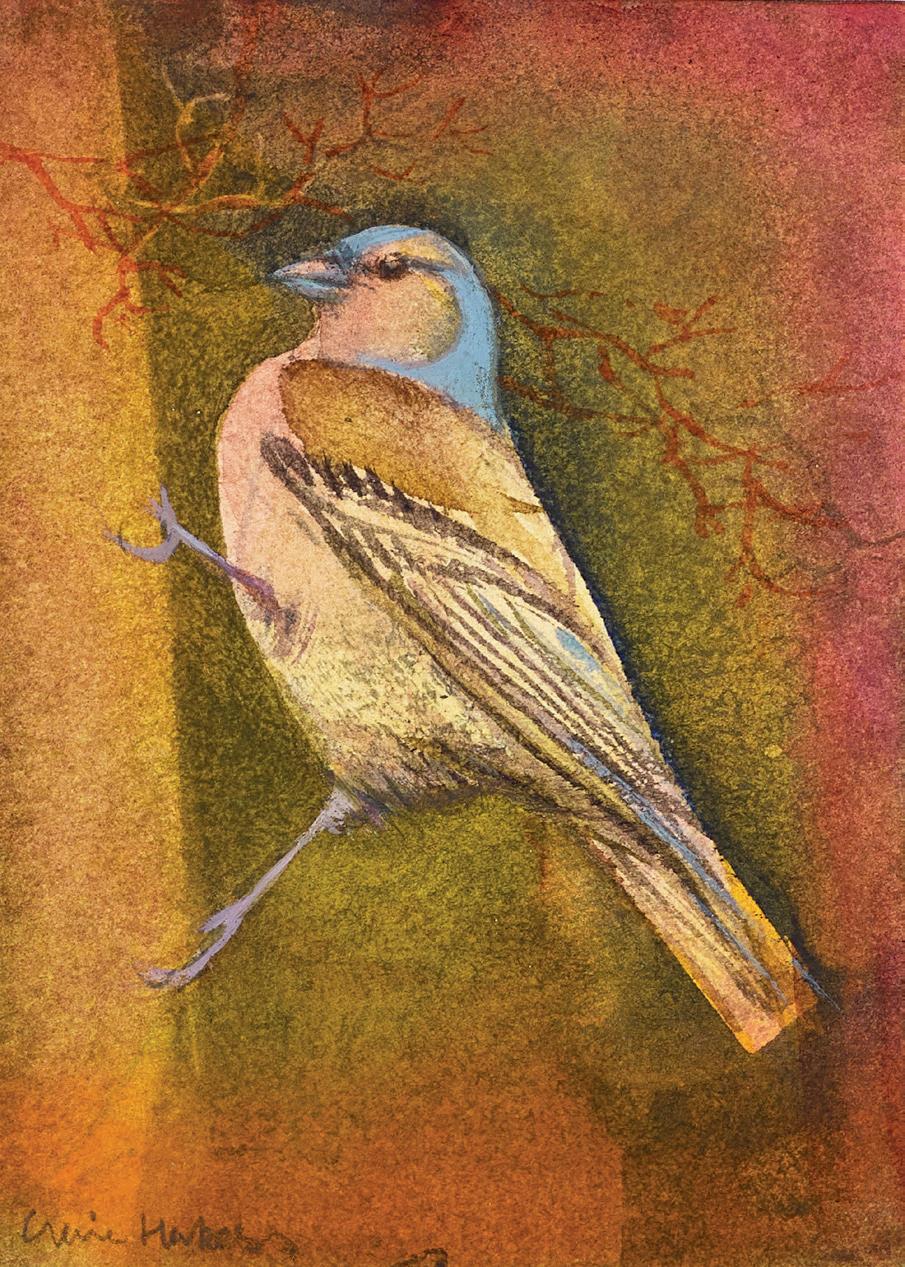
Garden Flock: Red Berries Waxwing, watercolour, 10 x 7cm
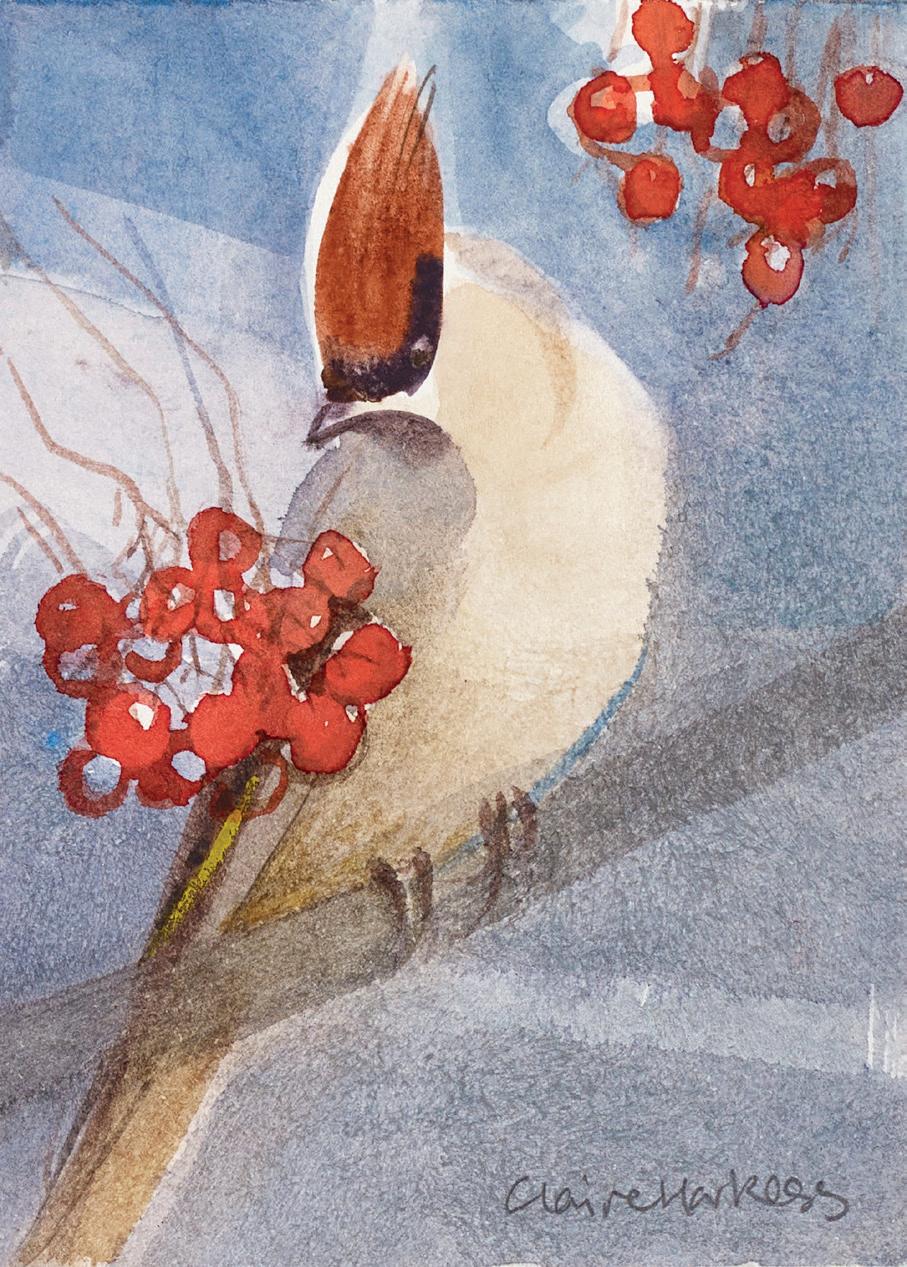
Garden Flock: Blacky, watercolour, 7 x 10cm
Garden Flock: Spring Robin, watercolour, 7 x 10cm


Garden Flock: Wren, watercolour, 15 x 11cm
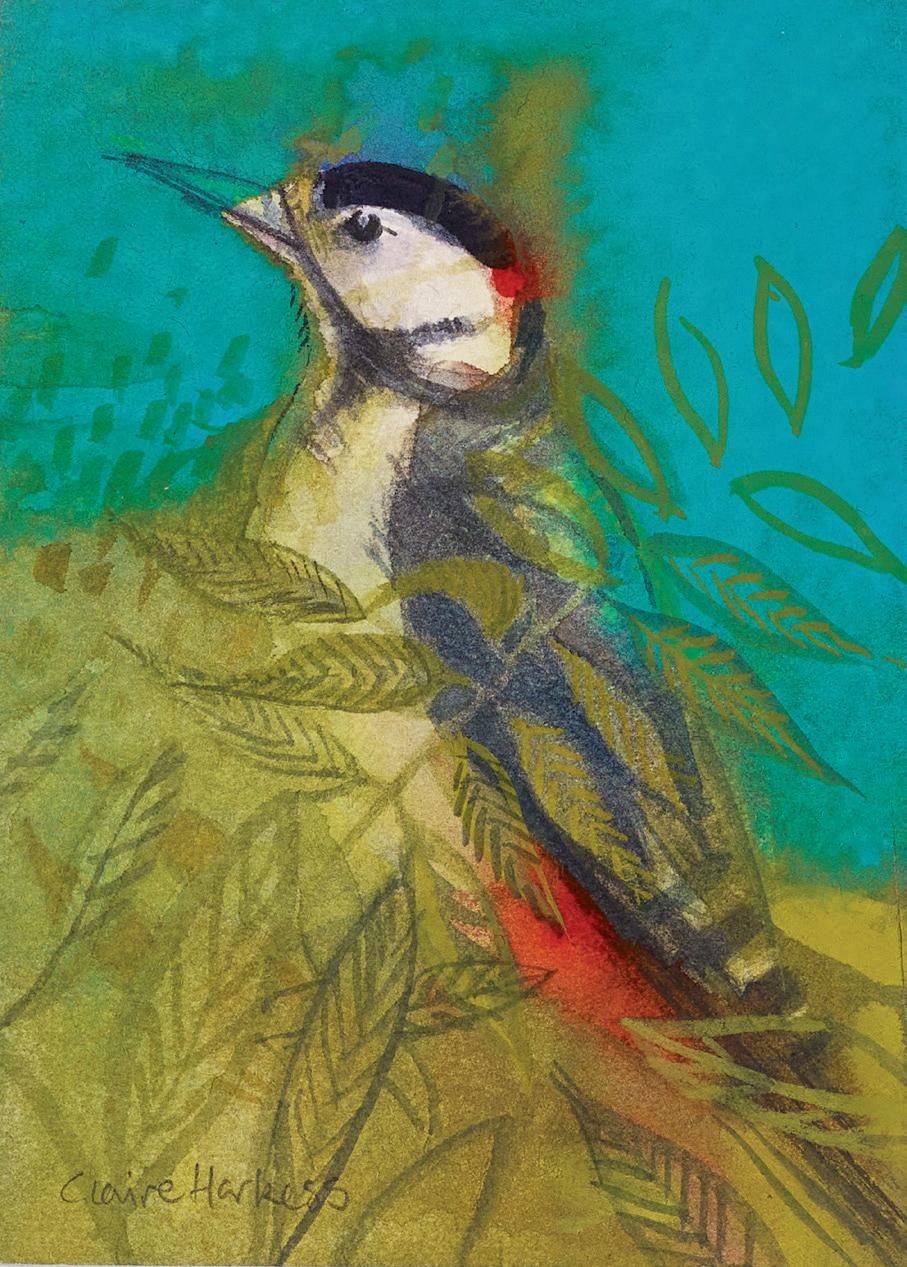

Garden Flock: Greater Spotted ii, watercolour, 10 x 7cm

Garden Flock: Mrs T H Lowinsky
Rhododendron, watercolour, 10 x 7cm
Garden Flock: Siskin, watercolour, 7 x 10cm
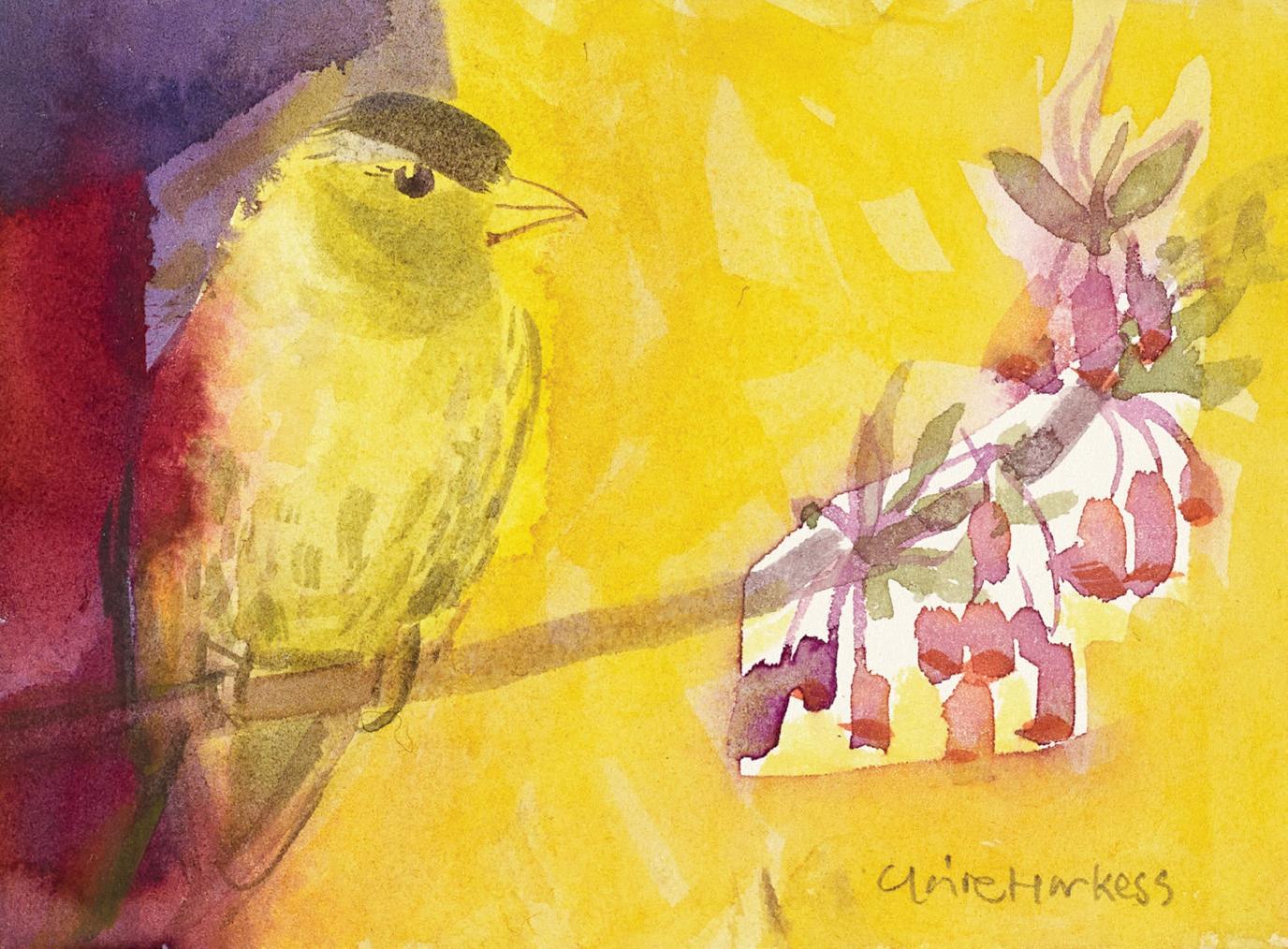
Garden Flock: Yellow Berries, Waxwing, watercolour, 7 x 10cm

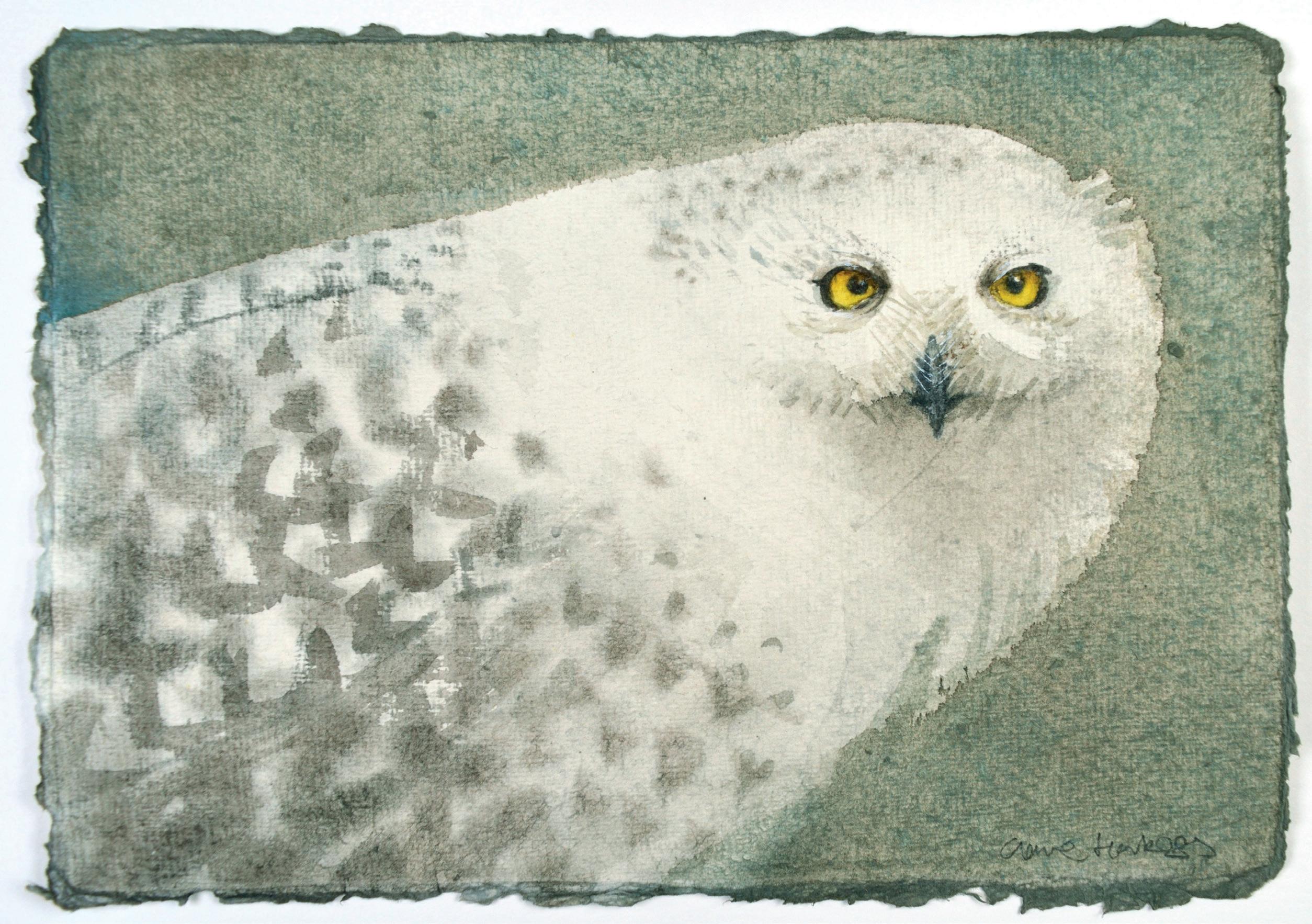
Long Eared, watercolour, 21 x 15cm

“Watercolour is such an amazing medium with so many wonderful qualities that keep paintings alive – different effects that can be created, luminosity, transparency…

When I’m painting a piece, it’s like having a conversation as I like to let the paint do as much of the talking as I do. I will start with an idea and try to coax the paint somewhere, the painting dries and moves and so does a little bit itself – it may try and pull me somewhere else. I like to get lost on purpose and diverge off my path, letting the paint flow and do its’ own thing.
Sometimes it can feel a bit of a challenge but it’s ultimately a beautiful flowing, organic process which perfectly suits the way I work and my chosen subject of wildlife.”
“Choosing the right tool for each painting is key. I’m addicted to brushes and work with a huge range - each one with very different qualities creating different effects. Chinese calligraphy brushes ranging from really fine ones with just a couple of hairs to really large ones, delicate sable haired watercolour brushes, flat hake brushes for huge sweeps, rigger brushes for wobbly lines and even brushes that have long passed their sell by date which can be used for texture and scrubbing.”
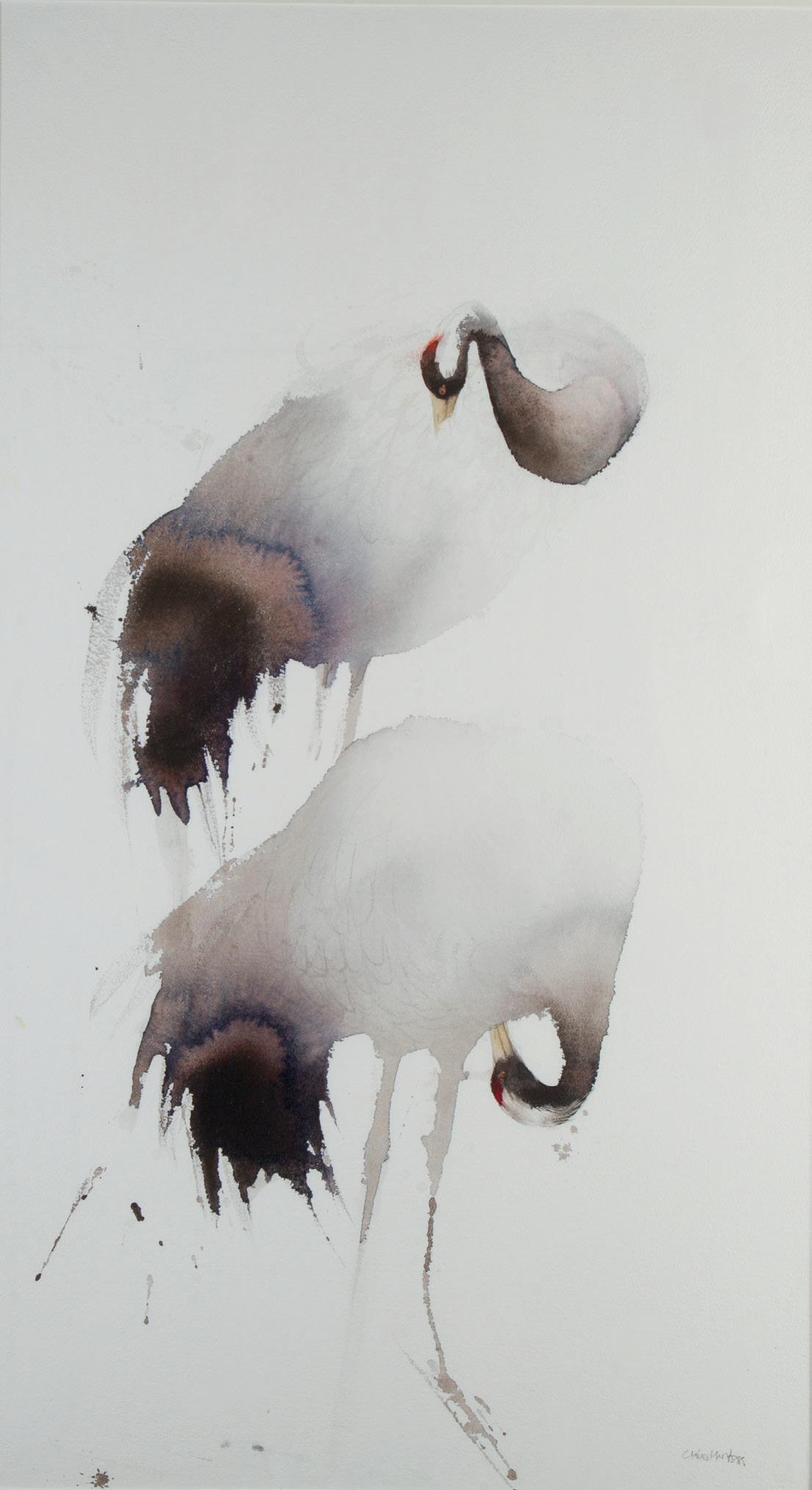

“Leaving areas of white space or quiet, very unworked areas in my paintings are important to open up the painting, let it breathe and show the animal painted with space to move or fly. I spend a long time before I start a piece considering the composition and where or how I’m going to place things, so that the finished piece appears as simple as possible – the effort to look effortless.”

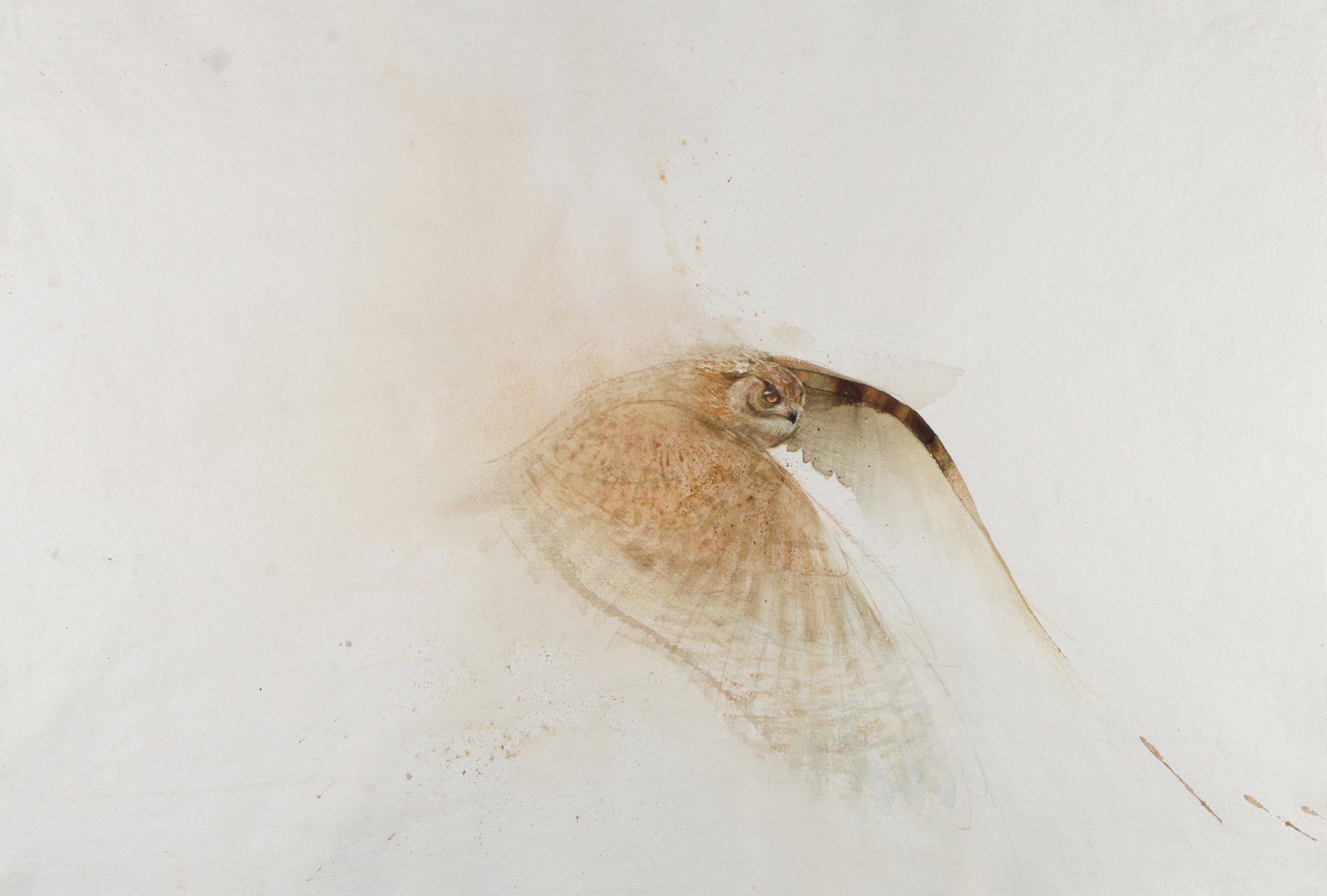

Tern i, watercolour, 50 x 70cm

Tern iii, watercolour, 56 x 76cm
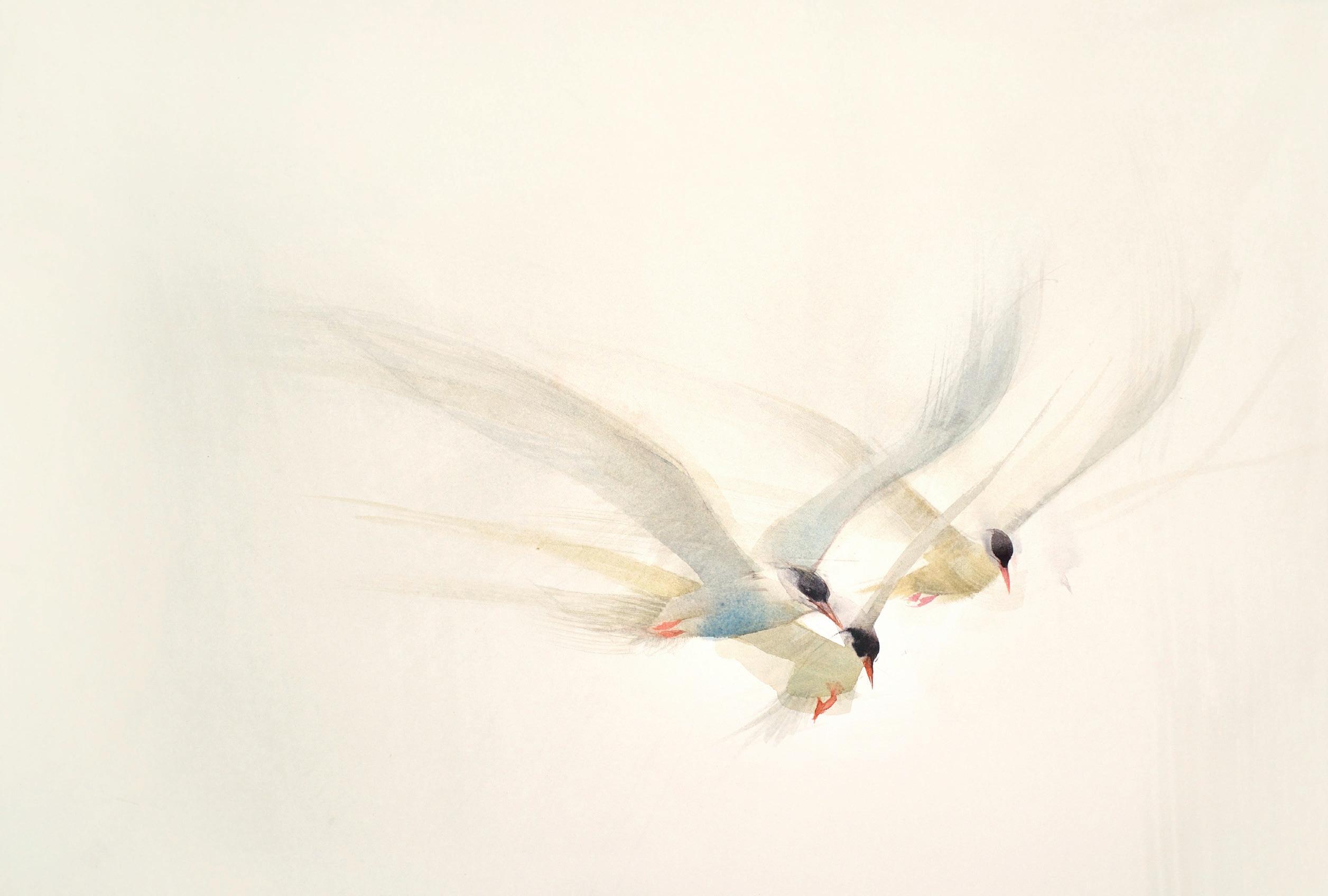

“In 2008 I visited China to participate in an exhibition there with a delegation of other artists. During this visit, we attended a demonstration of Chinese artists creating incredible paintings with brushes and ink. It was amazing to see, how they effortlessly moved their brushes using their whole bodies - it was like a beautiful, flowing dance. After the demonstration we visited an art shop and so inspired with what I had just experienced, I came home laden with different papers and brushes – some of which I still use today.

Painting on Chinese paper is a very different technique to the Western watercolour tradition and it was an amazing opportunity to work in a new way and discover new techniques. Since that trip, I have been on a continuing journey to discover more papers to use – there are thousands of different types - different fibres, different colours, different finishes. I’m addicted to finding and discovering new papers to use.
Each paper will have a different feel, so you need to treat them differently when you paint on them - some of them are very absorbent, others less so – one you need to flood with paint, another is for more intricate work. All Chinese papers are incredibly thin and transparent but as many are made from mulberry fibres, which are very long, they are a lot stronger than you think they would be.”

Due to the transparency of the Chinese papers that Claire uses, the process for mounting them for framing is incredibly laborious and time consuming and has taken a great deal of time to perfect. Firstly the painting has to be moistened and then a wheat starch paste is painted on the back. A backing sheet is then applied over the painting as carefully as possible to ensure no wrinkles and creases. After allowing to fully dry, the painting and backing sheet are then attached to a separate board so that the piece can then be framed. The larger the painting, the more challenging the process due to the fragility and wrinkly nature of the painted paper – weeks of work can be completely ruined if the mounting process does not go smoothly.
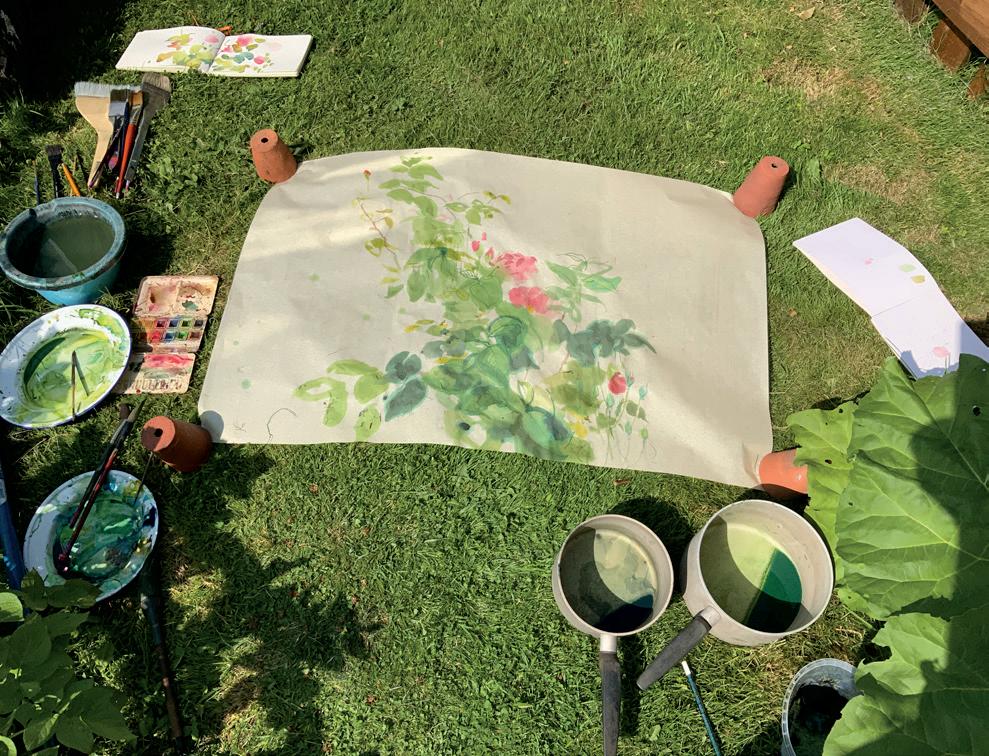
Early Spring, ink, 30 x 45cm
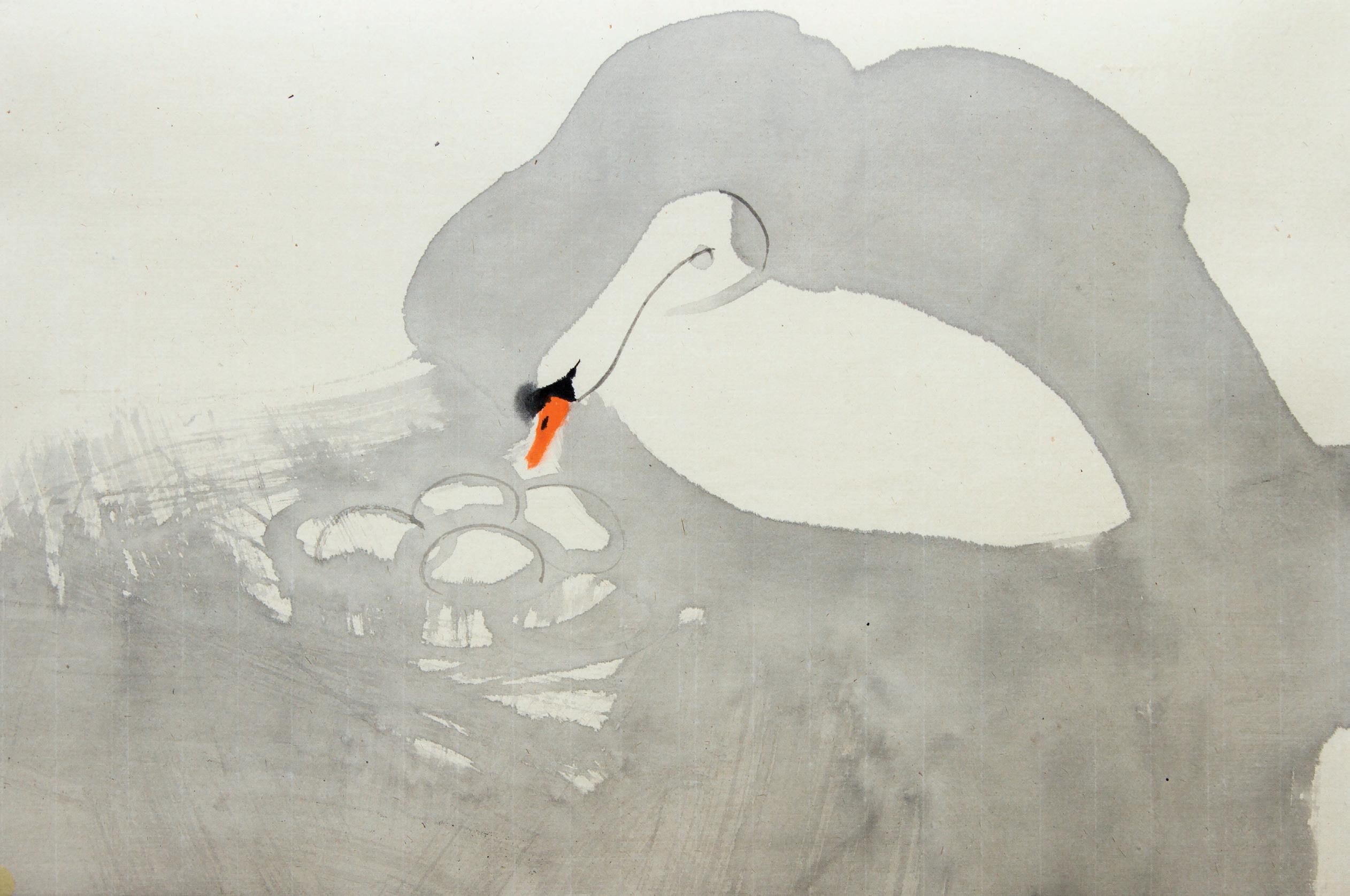

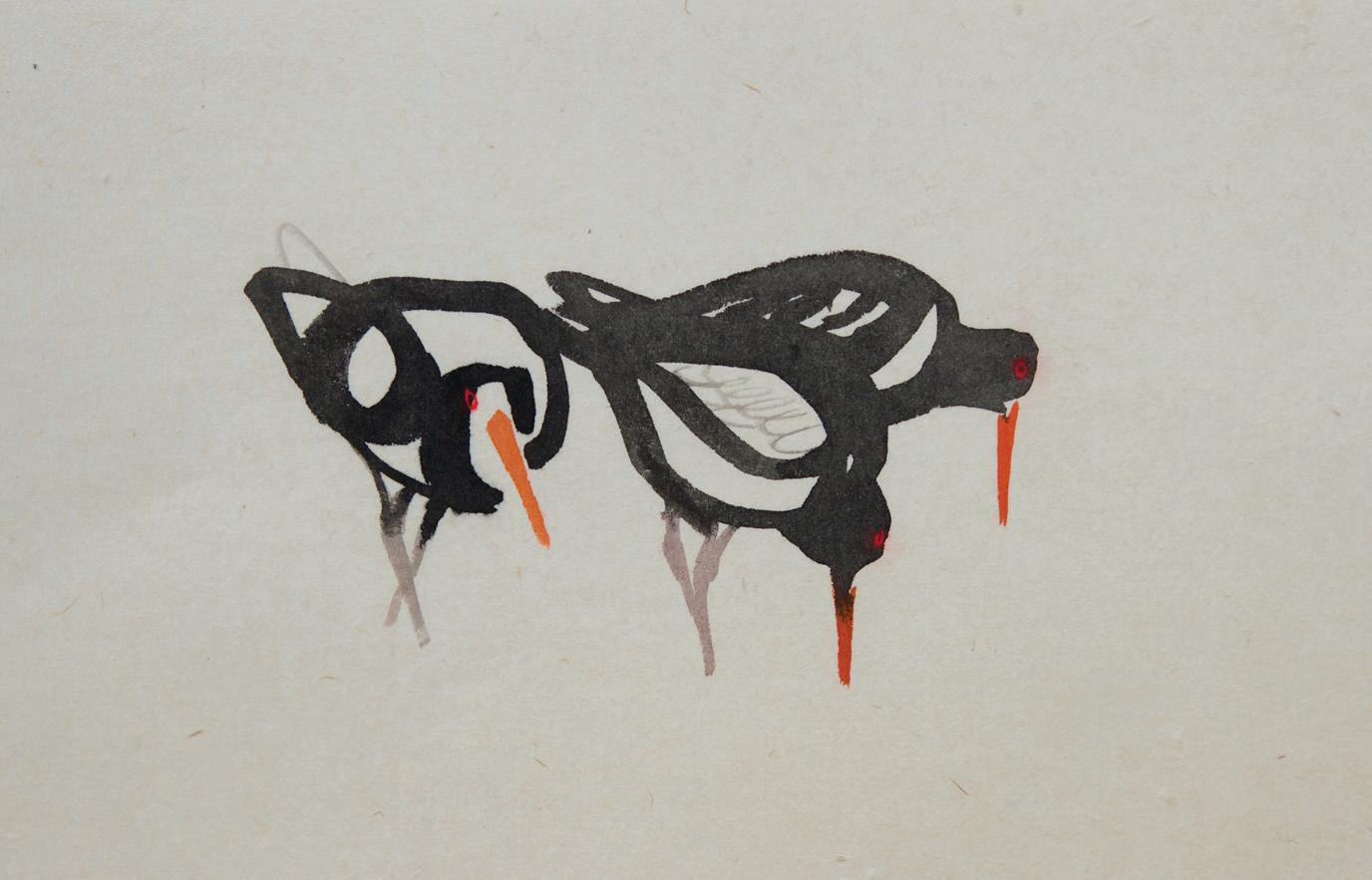

Cloudless on the Longest Day (Mrs T H Lowinsky Rhododendron), watercolour & 23.5g gold leaf, 69 x 138cm

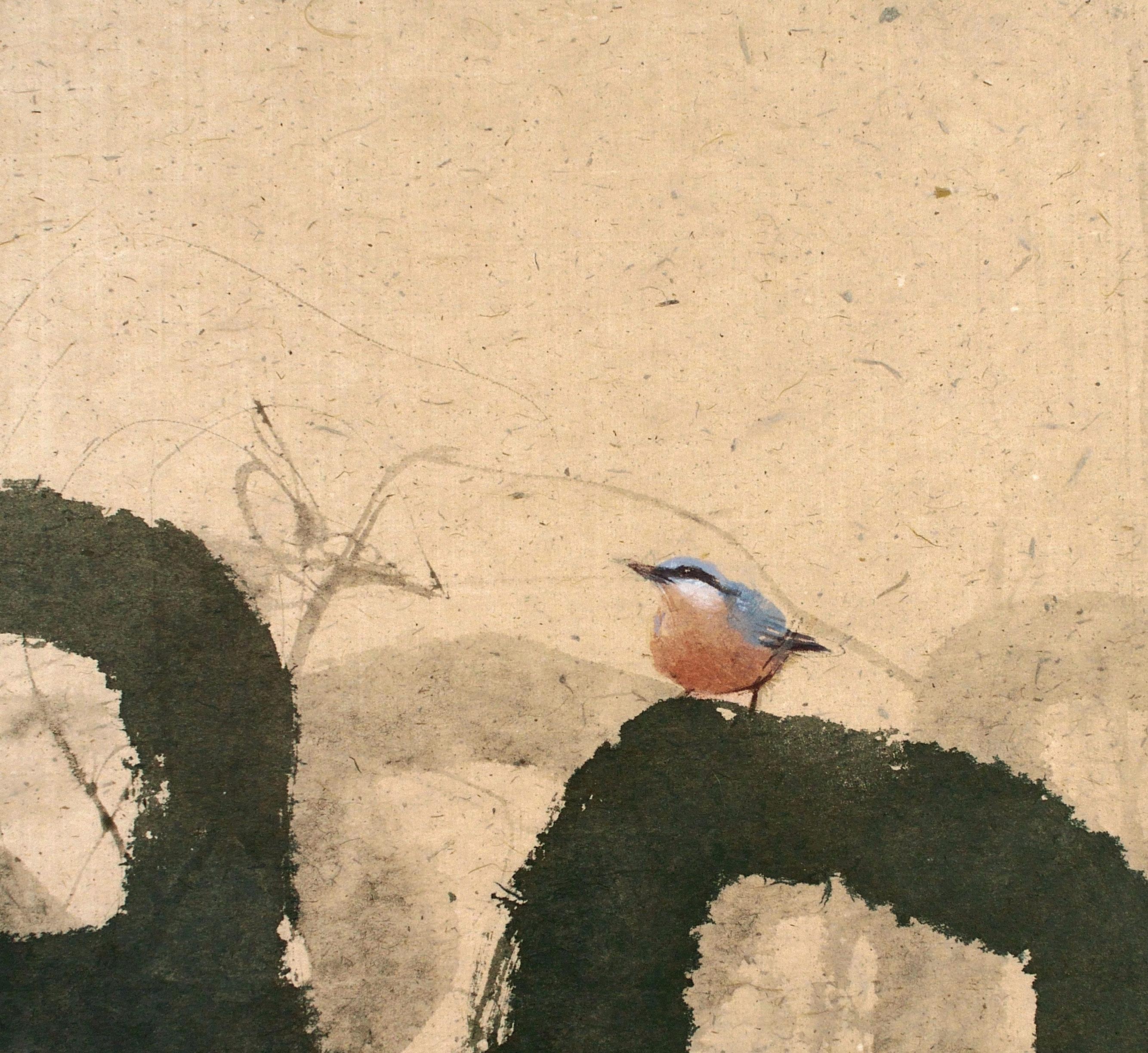
Eye-stripe, stump-tail, blended browns: Wren - completely there (Chris Arthur)
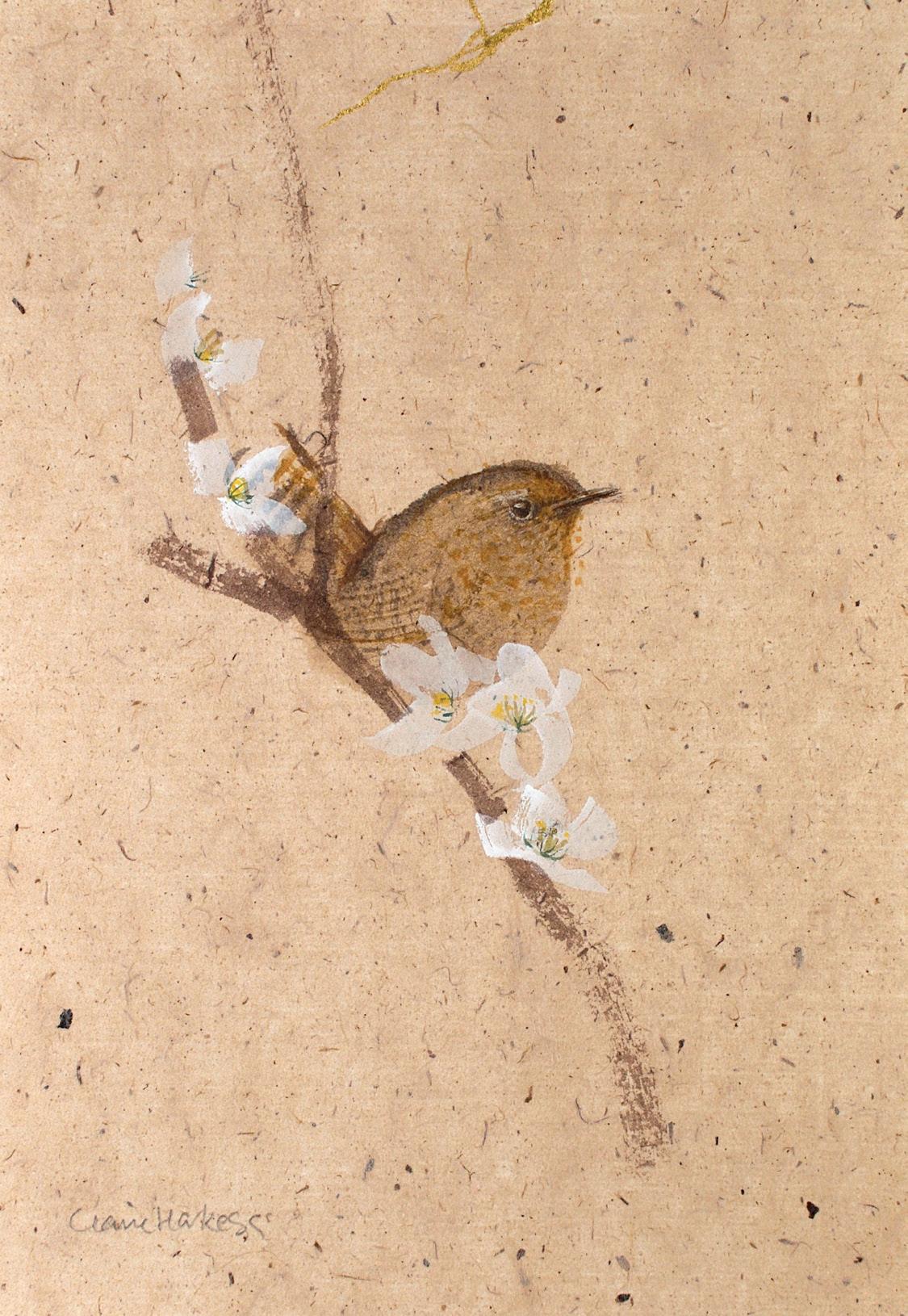
April Blossom i, watercolour, 21 x 14cm
Bullfinch i, watercolour, 24 x 17cm
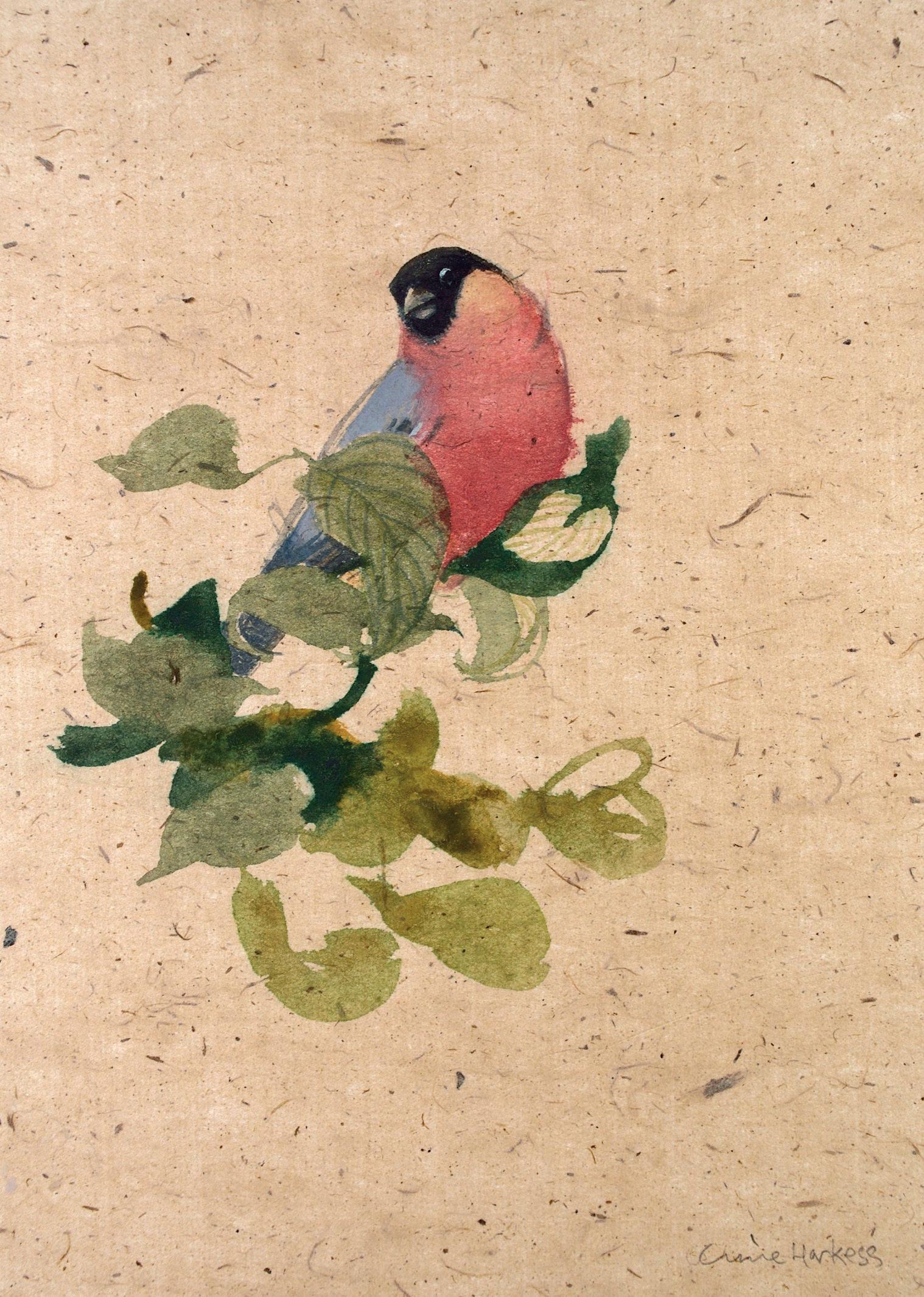



A Great Tit from the Orchard, watercolour & gold leaf, 30 x 30cm

“Over the last couple of years I’ve introduced gold leaf into my work, inspired by the ancient Japanese technique of ‘kintsugi’ (golden joinery) of restoring broken ceramics. The cracks in the ceramic piece are left visible and filled with lacquer or gold so that the piece is seen as stronger and more beautiful than before. Through my collage work I sometimes include hairline cracks of gold where the paper joins, which lifts the finished piece and adds more to its story. Gold is a precious and beautiful material to work with and I find this such a calming process – so intricate and detailed and a lovely contrast to painting itself”.

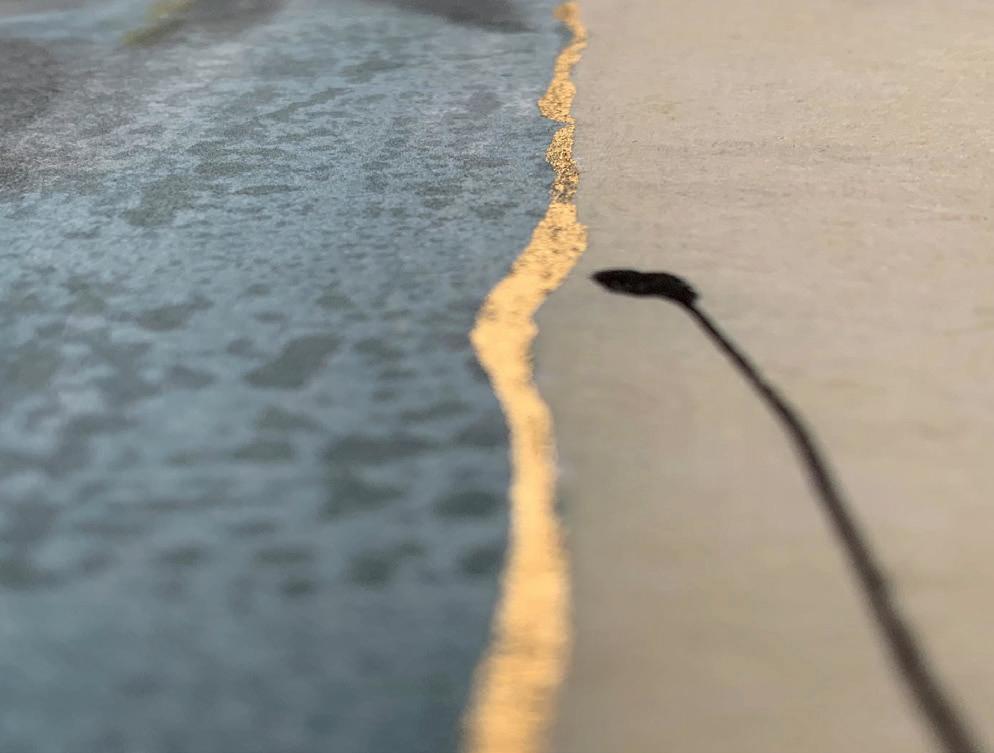
“Incorporating collage brings a quality that cannot be expressed through paint alone. I enjoy bringing together disparate elements –treasured painting segments, various paper types or printed script. I spend hours and hours in my studio just working with each of these elements to create the right composition.”

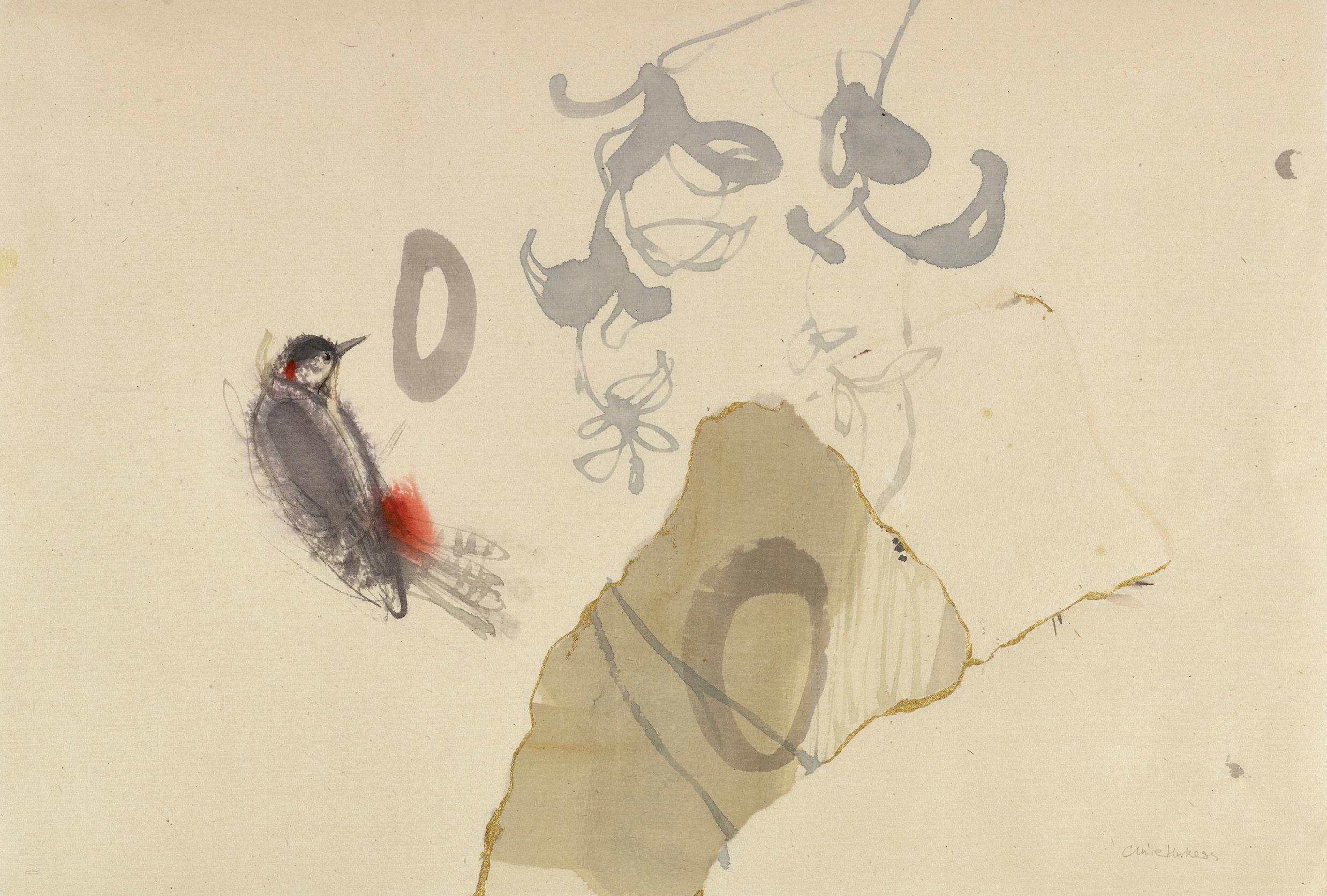
November Rain, watercolour, collage & 23.5 gold leaf, 33 x 67cm
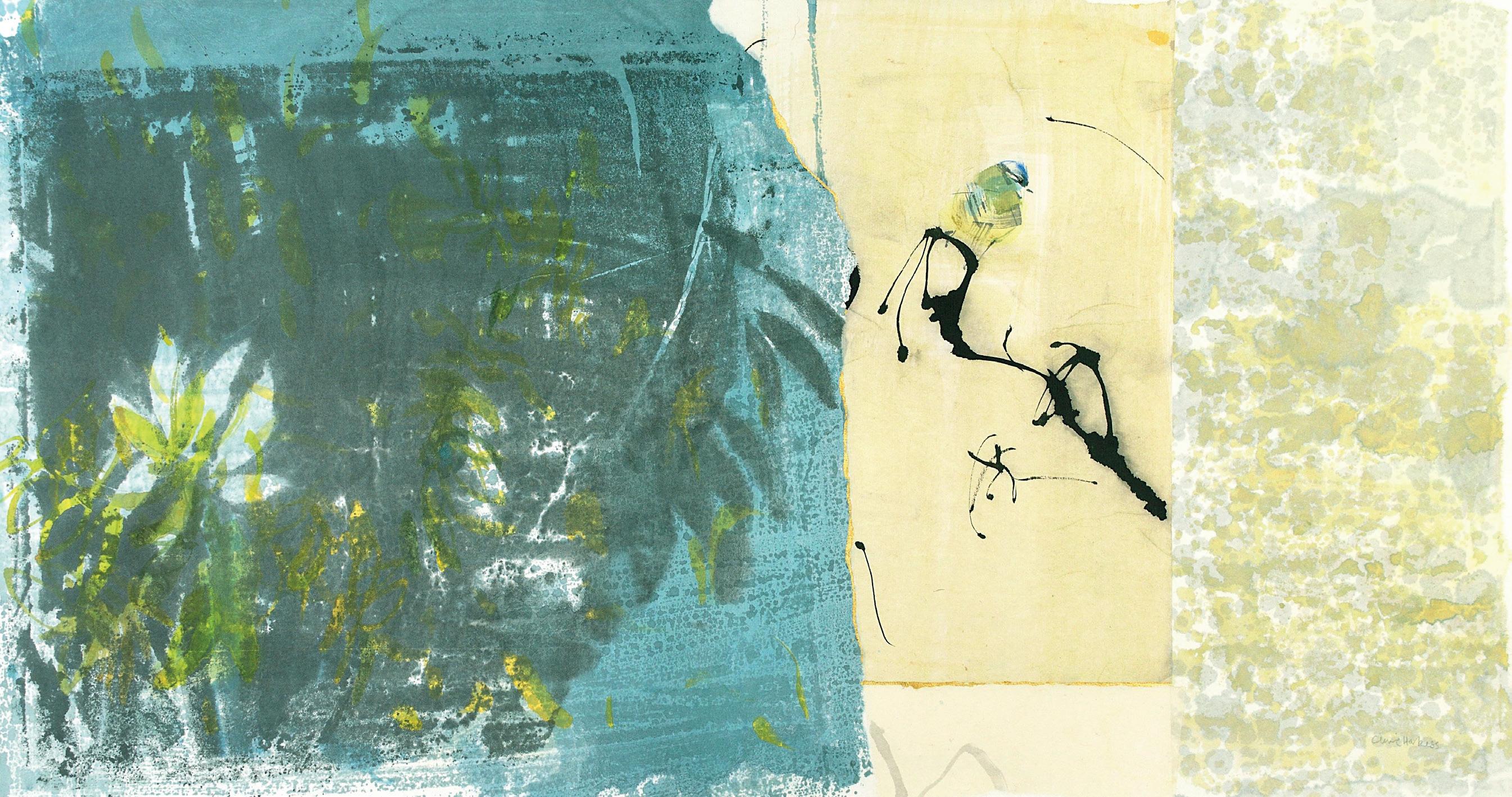
Blue ii, watercolour, 24 x 16cm
Great Tit, watercolour, 15 x 11cm

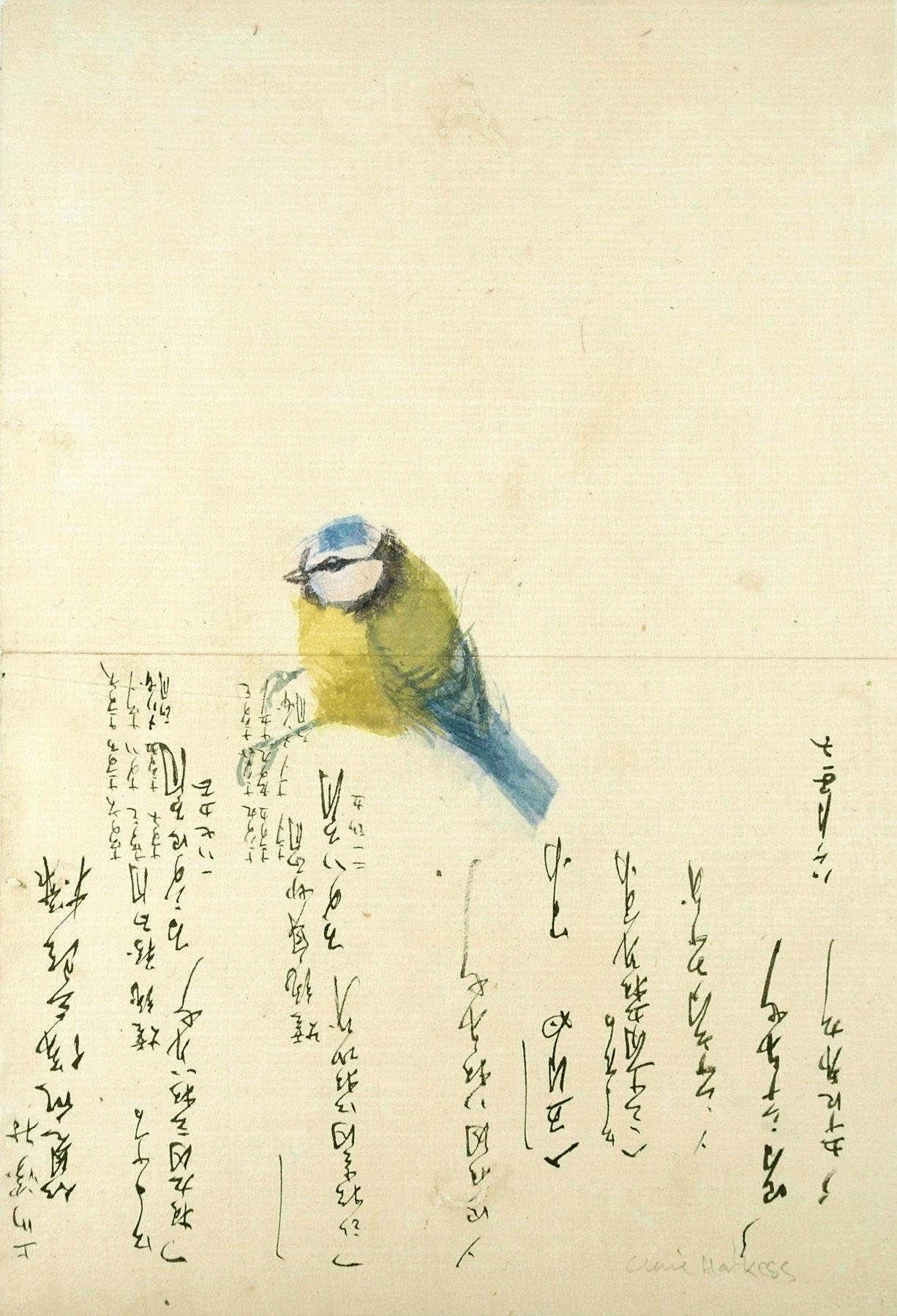
“I came across some old Japanese and Indian ledgers which I’ve then taken apart and used the individual pages to paint on and use in my collages. I feel it’s a lovely addition to my work and I use it in a very abstract way, adding texture, pattern or shape. I sometimes paint little birds perched on the text of the ledger like a twig, or the heavier weight text reminds me of the bark of a tree.”


Headfirst Nuthatch Descends, watercolour & collage, 31 x 36cm
Jay, watercolour & collage, 49 x 31cm
Slowly Emerging, a World of Sun and Colours, Heralded by Birds (James Hackett), watercolour, 108 x 65cm
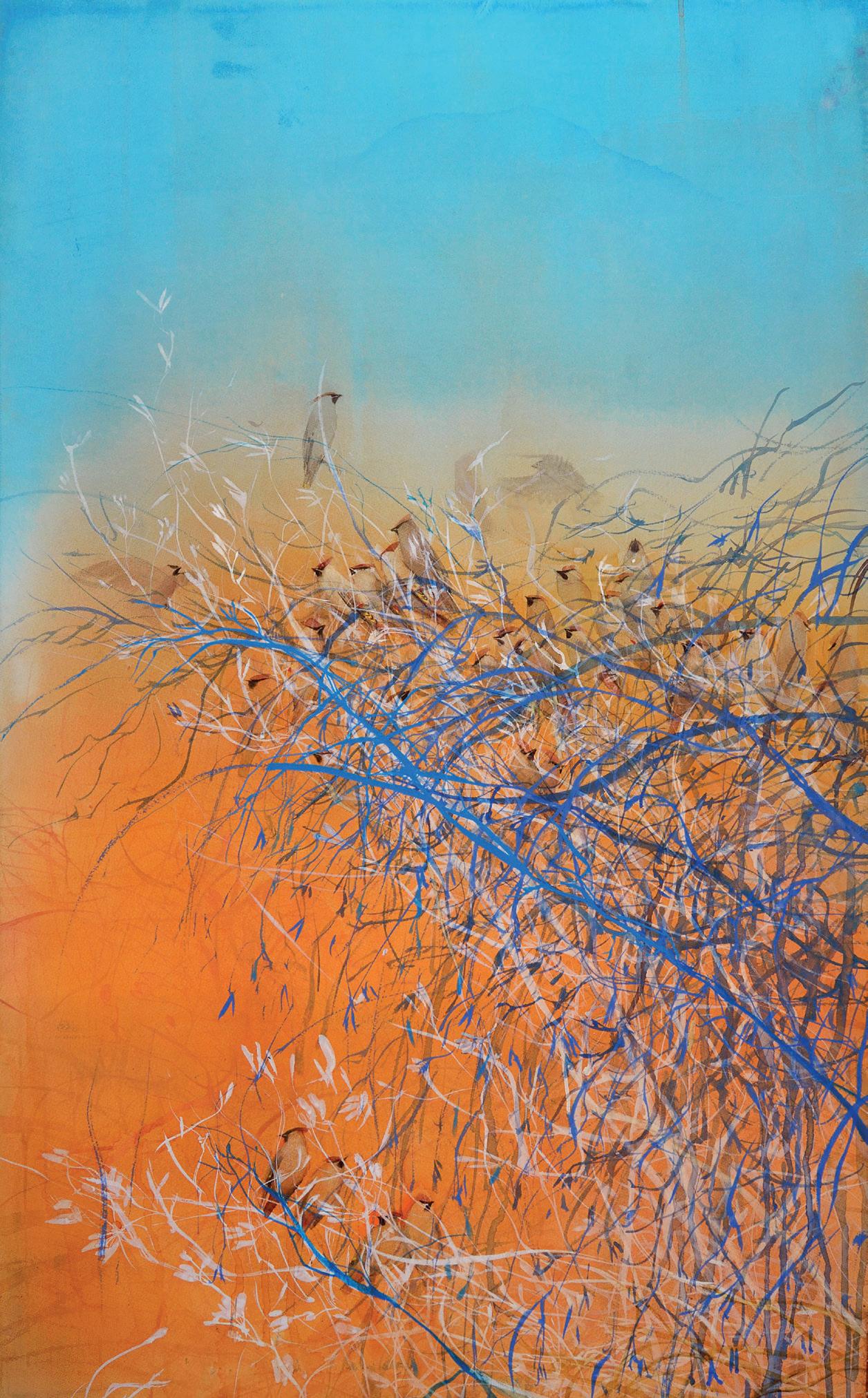
“I love working on heavy weight papers. This is an entirely different approach to the Chinese papers but I like working on the two techniques side by side. It’s really lovely to paint in such vibrant colours and due to the translucency of watercolour, lots of unexpected effects can happen – runs, layers and other colours can be created in a completely unique way.
When I start a painting, I may have a loose idea in my head, but after flooding on and building up layers of colour and then scrubbing it back, the painting will evolve and dictates which way it’s going to go organically. Sometimes it can go in a completely different direction to what I initially thought - sometimes I can let a painting sit for years before deciding what to do next…
When you scrub out watercolour paint, it is never erased completely. Left behind are really beautiful ghost images and surprising effects. You then have a lovely subtle surface to start from again with abstract shapes which ultimately become part of the composition.


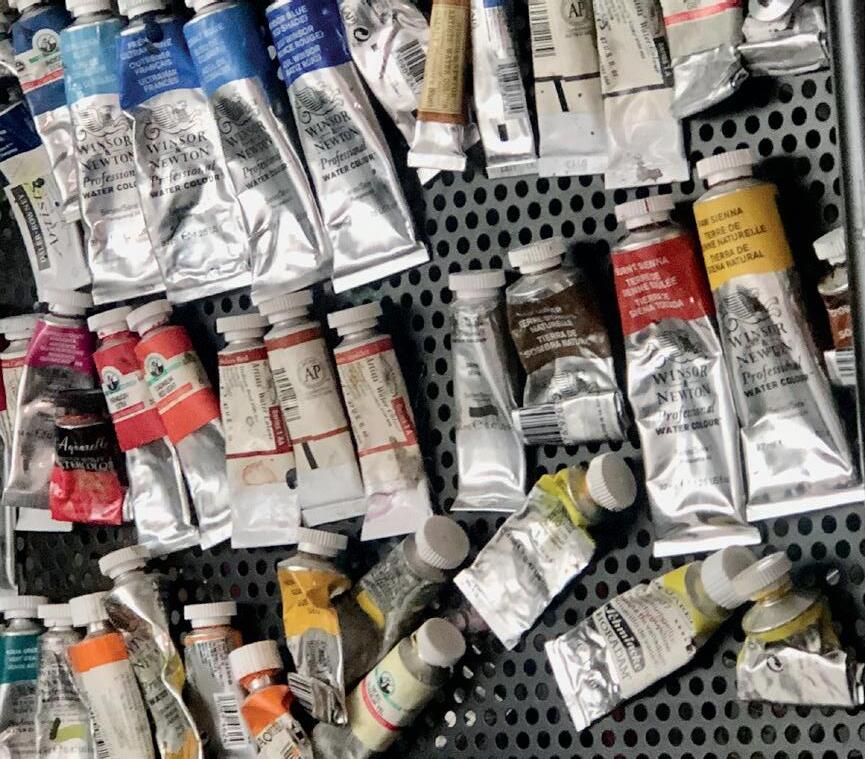
I love nothing more than letting the watercolour and its qualities speak for itself – losing control and then getting it back.”
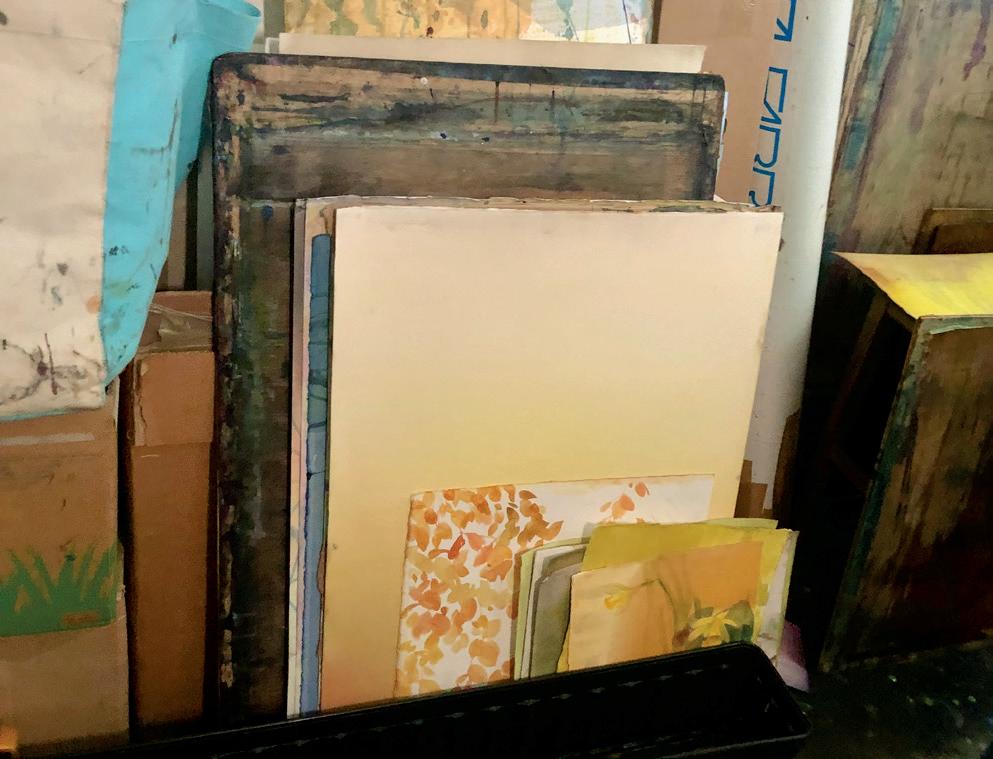

Winter Song, watercolour, 65 x 110cm

Runs up, down, around Treecreeeper on pale ash trunk More bark-mouse than bird (Chris Arthur)
Quietly Tree Creeping, watercolour, 56 x 76cm

Resplendent goldfinch

Beyond words’ dreary plummage
Its bright perfection (Chris Arthur)
Rain Charm, watercolour, 56 x 76cm
Empty the night seems Yet endless flights of birds
Calligraph the moon
(James Hackett)
Empty the Night, watercolour, 56 x 76cm

Solitary Night Song, watercolour, 56 x 76cm

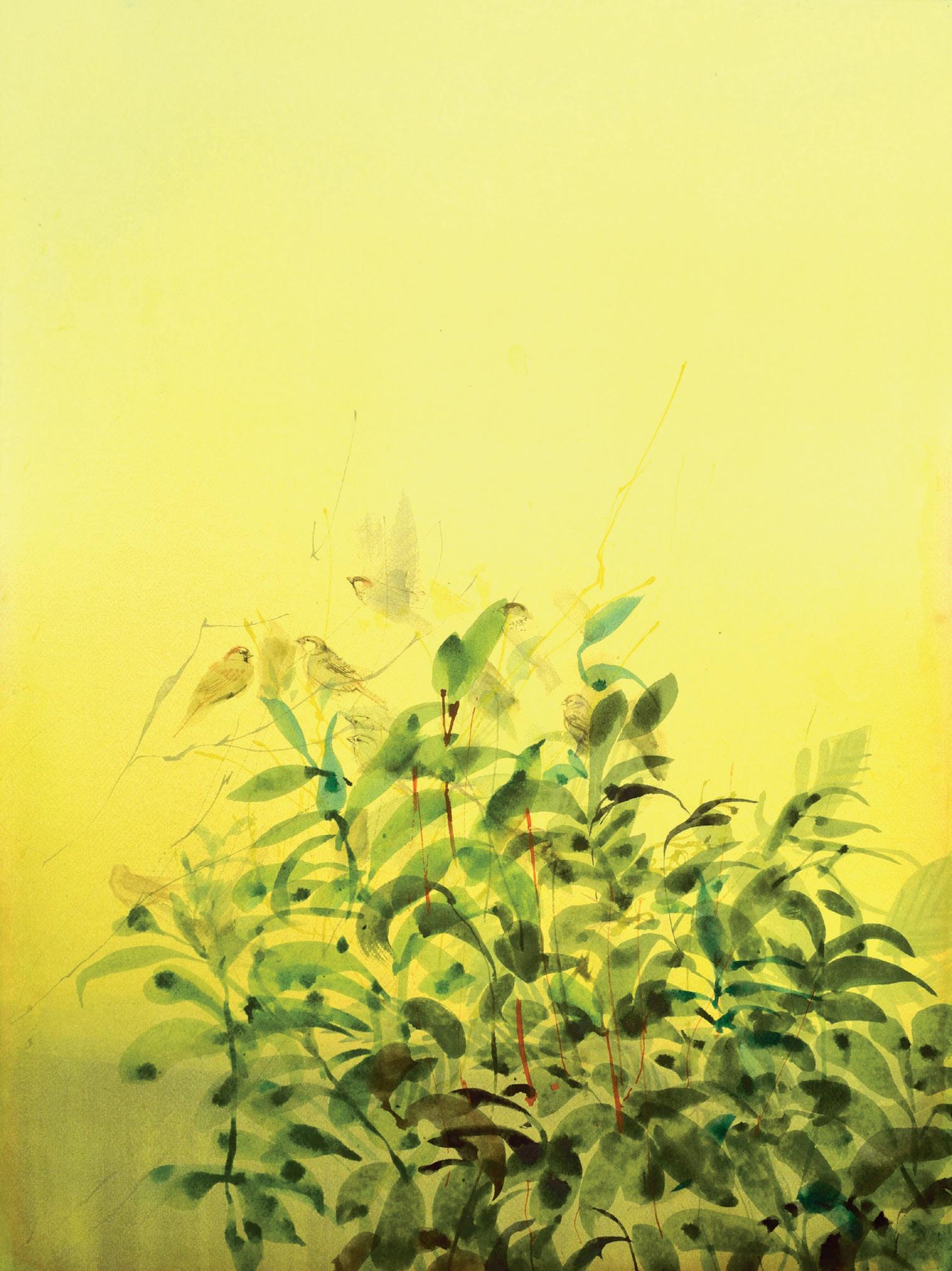



Brambling Flock, watercolour, 56 x 76cm
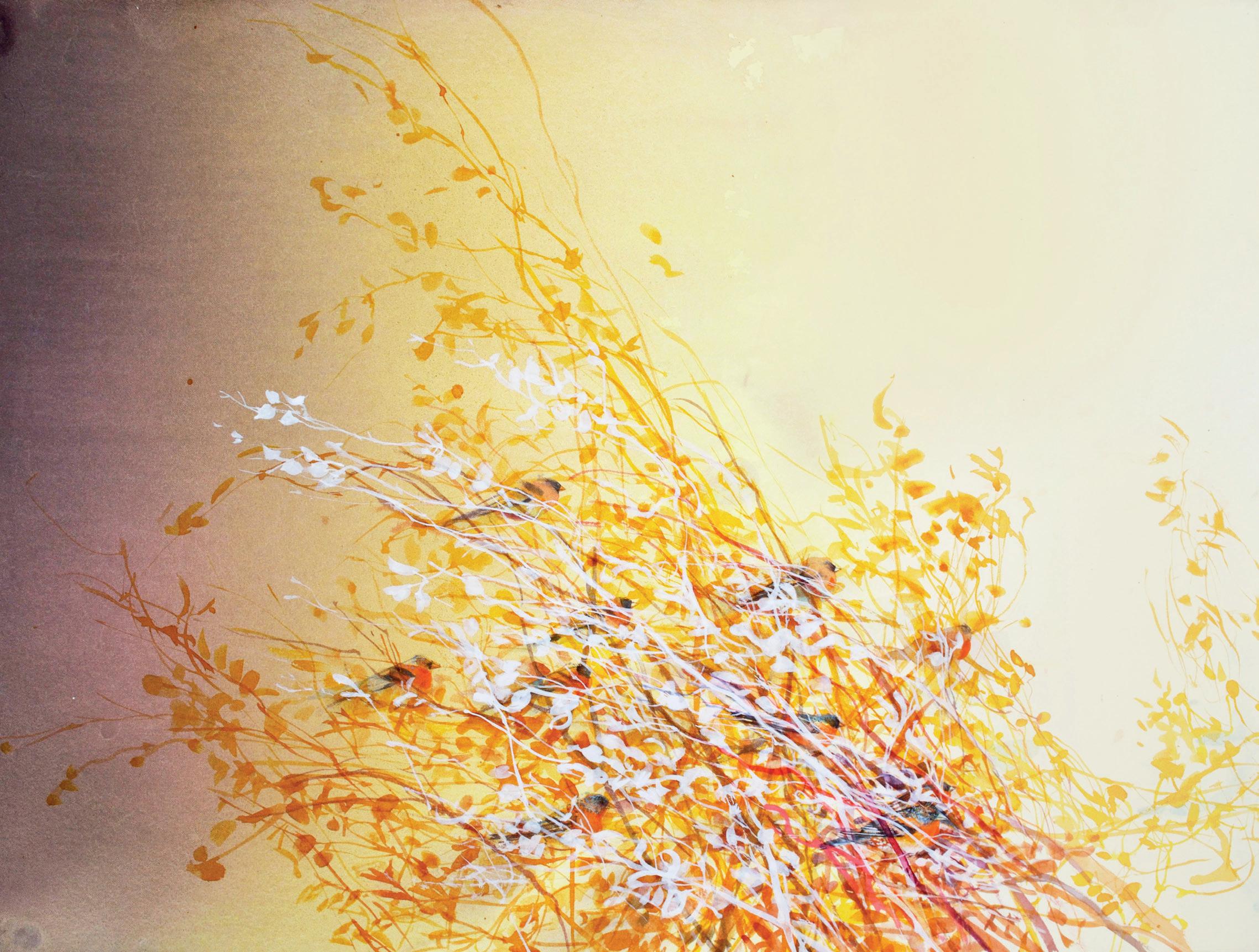
Artist Acknowledgements:

With thanks to
The Strathearn Gallery

Argaty Red Kite Centre

Chocolate Films
Eric McCabe
Extra special thanks to John, always
Claire Harkess has selected Haikus from Chris Arthur and James Hackett to accompany her work. Special thanks to Chris Arthur for granting permission to print his haikus featured in Northwords Now.
